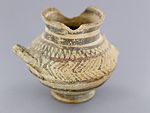Jarlet
About this object
History of use
Primary function of this form was utilitarian but could also serve funerary function in the form of grave goods.
Narrative
This collection was said to have been acquired by James George during his service in Greece (Athens) from 1945-48.
Cultural context
utilitarian; funerary
Physical description
Jar made of grey clay consisting of a small globular body with base, wide neck and flaring rim. Originally two ring handles emerged from body at upward angle but one now missing. Decoration poorly executed in dark brown becoming red-brown on light brown colour of body. Painting consists of two horizontal bands on inside of rim and two on outside surface of neck. Below this is another line then a zigzag band, followed by a line and a horizontal band of chevrons. Below the chevrons is a line then three dark bands to the foot of the jar. Upper surface of surviving handle shows signs of decoration underside of base left reserved.
Date Acquired
28 Nov 1985
How Acquired
Donated
Credit Line
Measurements
Overall: 8.8 cm x 10.8 cm x 7.8 cm
Object Number
Ce236
